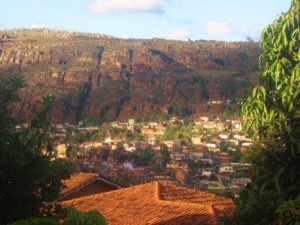
Photo © Michael Sommers.
As anyone who’s ever done it can attest, falling in love is a lot like traveling to a new, previously unexplored country. Along with the thrill, wonder, and adrenaline-filled sense of adventure, there are recognizable signposts, moments of déjà vu, of shocking familiarity, of been-there-done-that, as well as moments in which you discover you’ve suddenly entered unchartered territory without a map (or GPS) to guide you.Sometimes love and travel intersect not just metaphorically, but literally as well. They did to me, this week, when I traveled from my home in Salvador, Bahia to visit a new love of mine who lives in Diamantina, Minas Gerais. Funnily enough Barbosa is a Bahian who was born and raised in Salvador, but for the last 13 years has lived in this colonial diamond mining town some 4 hours north of Minas´ capital of Belo Horizonte.
Coming from Bahia, Minas always strikes me as a different country.This isn’t the first time I’ve been to Minas or even to Diamantina. In a funny twist of fate, my previous boyfriend, Luiz, was a Mineiro who came to live with me in Bahia (and who still lives there). On a couple of occasions, I was fortunate enough to spend ample chunks of time with him in various parts of Minas. Discovering Minas helped me to discover Luiz.
Coming from Bahia, Minas always strikes me as a different country. The landscapes, cities, food, climate, and skies are different as are Mineiros themselves, their culture, their accents, their “jeito” (way of being). I’m always surprised that Bahia (specifically Salvador and the surrounding Recôncavo region) has become such an ingrained point of reference for me, especially viewed that the fact that it diverges so wildly from the Great White North where I grew up.
Unlike Minas’ other colonial towns, whose wealth was derived from gold, Diamantina’s fortunes were sealed by the astonishing quantity of diamonds waiting to be harvested from the rocky Serra de Espinhaço mountains surrounding the town. Outcrops of these were discovered in the 18th century and once the word got out, this isolated region was mobbed by fortune seekers. For the next 150 years – until diamonds were found in South Africa – Diamantina was the largest producer of these glittery rocks in the world (to this day, it remains the largest diamond producer in Brazil). Generations of miners, cutters, and jewelers still prosper, and the dream of striking it rich continues to nourish the locals, who were raised on tales of fortunes made and lost.
The first time I came to Diamantina with Luiz, we discovered it together as tourists (it was his first time as well). We stayed in pousadas where we were fed monstrous Mineiro breakfasts replete with sublimely robust local coffee (Minas produces some of the world’s finest Arabica), myriad cakes, biscuits, and cookies, and one of Minas’ most beloved specialties, pães de queijo; golf ball-sized “cheese breads” whose crunchy outer core combined with a cheesy, chewy interior are hopelessly addictive.
We clambered up and down the steep hills whose giant cobblestones were laid by slaves who came to work the diamond mines. We ducked into all of the town’s baroque churches as well as the childhood home of Brazil’s “bossa nova” president, Juscelino Kubitschek (the man who built Brasília), and the home of local legend, Chica da Silva, a former slave who, as mistress to the richest man in town in the early 1700s, transformed herself into a grand society dame as well as a national heroine immortalized in Cacá Diegues’ 1976 film, Xica da Silva.
This time, however, I am experiencing Diamantina very differently. Instead of visiting, I’m suddenly, temporarily living here. Having been catapulted into Barbosa’s house – and life, the city now comes at me through the filter of his eyes and the world he has created here. Although I recognize streets and churches, restaurants and vistas, they’ve mysteriously morphed from tourist attractions into random reference points for meeting up with groups of friends.
For meeting up, but not for hanging out. Despite the balmy weather, we’ve rarely sat outside at scenic outdoor street bars as we do in Bahia. Instead, hewing to Mineiros’ love of congregating around the hearth (wood-burning stoves are rampant), we shuttle from house to house, where we’re warmly received with bottles of locally produced cachaça (another Minas specialty) and slices of hard, tangy cheese from the nearby town of Serro.
In and between, we meander – (or zoom by car; a godsend viewed the brutal steepness of the city streets) – through the labyrinth of white-washed, blue-shuttered houses and palaces of the colonial center as if they were scenic afterthoughts. The beautiful backdrop of intense blue sky pierced by mountains is no less beautiful, but it’s also somehow strangely, but pleasantly banal, the scenery of people’s lives – including for the time being – mine.